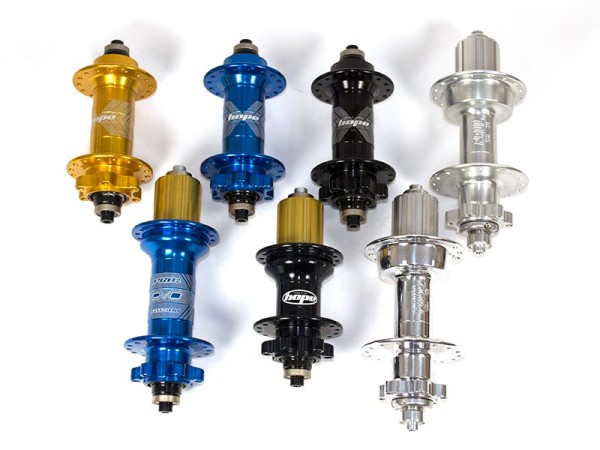This article is part of the Fat-bike 101 series and is intended to help new fat-bike owners, and potential fat-bike owners, with some of the questions they may have about fat-bikes. In addition, it is a chance for experienced riders to add comments to help our new brethren enjoy all that fat-biking offers. Consider these articles as conversation starters, not exhaustive explanations!
Hubs make the wheels of your fat-bike go ’round. Or, at least, they are part of the equation. If you bought a stock fat-bike you likely didn’t give much thought to the different “standards” available but when it comes time to replace a hub or upgrade your fat-bike to a new model there are a few items to be aware of.
135mm Rear Cassette Hubs for Offset Frames
135mm hubs were the original choice for modern fat bikes and, because they are the standard of the MTB set, there are literally hundreds of choices here. If you bought a stock Pugsley, you have a 135mm rear hub and if your’s gives up the ghost you have a TON of choices for replacement. So many choices, in fact, that we couldn’t possibly go in to all the possibilities. Of note though is that most of the more specialized fat-bike hubs listed below started and/or evolved from an existing design so any of the top quality manufacturers would be a great choice.
Internally Geared Hubs
Quite a few pundits out there are declaring the death of the offset, 135mm fat-bike frame. However, if you are a fan of Internally Geared Hubs (IGHs have all the gears enclosed in a sealed hub so your drive bits are a lot more protected that a traditional derailleur system) you will still have to consider an offset frame because the most popular hubs all have 135mm axles and the prospect of that changing anytime soon are pretty slim. Some of the most suitable IGHs for fat-bike use include:
Symmetrical Fat-bikes
As fat-bikes have become more popular the feasibility of making hubs specifically to address some of the challenges of building a fat-bike with a symmetrical wheelset have been addressed. The 170mm spec has become the defacto “standard” for building symmetrical fat-bikes but there are some 160mm, 165mm and even 190mm hubs out there so, if you have a special need, you should be able to find what you want.
170mm Rear Cassette Hubs for Symmetrical Frames
- Salsa 170mm (both Alloy and Steel freehub bodies)
- Hope FatSno (stock with an alloy freehub but a steel version is available)
- Paul Components Disk RHUB 170
- White Industries SnoWhite
- Phil Wood
- Fatback
- 616
- 9:Zero:7
Front Hubs for Fat-bikes
In the beginning of the modern fat-bike front hubs were actually 135mm single speed rear hubs simply used in the front. This facilitated a redundancy in the drivetrain for people exploring a long way from home.
While just about any 135mm disk rear hub could be used on the front of most fat-bikes modern 135mm fat-bike hubs have evolved into a more front specific design. Whether it is simply the lack of any freewheel threads or a new standard for the front disc spacing, front hubs can be tailored to specific uses. Some of the more popular for fat-bike use include:
- Paul Components Dick WHUB
- Hope FatSno Front
- Salsa Enabler
- Surly Ultra New Disc
- White Industries SnoWhite
- Phil Wood
- 9:Zero:7
What is the deal with two different disc brake spacings for front hubs?
While most fat-bikes still use a Rear Disk mount standard for the front fork enabling the use of a wide variety of 135mm hubs several high performance fat-bike forks, including the White Brothers Snowpack and the Carver Carbon, were designed to take advantage of the new, Front Specific, disk standard that allows the left side hub flange to move outboard resulting in a stronger, dishless build.
If you are an experienced fat-biker please consider leaving a comment below to help newbies get maximum enjoyment from their ride.
If you have a topic you’d like for us to open up a dialog on, please send us a note to fatbike101@fat-bike.com and we will do our best to cover it.


You are missing the 9:zero:7 hubs. I don’t see them talked about much, but I would take the quality, bearings, and freewheel over many “high end” hubs I have used in the past, including my DT 240’s on a past mountain bike.
Thanks for the reminder, Charly!
sadly for me 9:zero:7 hubs are very disappointing. I turned apart two of them in one season. I would not recommend them to anyone
Death of the offset frame? In my world IGHs are the way forward, death of the derailleur is more likely. Until geared hubs are 170mm, I’ll be offset all the way. It’s a question of whether you want your expensive delicate moving parts out in the breeze and mud, or safely in a little box full of oil. Only time will tell…
Greg how can I find a 135 mm hub or complete set front wheel for a mongoose dynamo
Also need to consider on front hubs some use a 9mm axle others a 10mm axle. Make sure your hub matches your fork and vice versa.
And why is it that we’re going towards 142x12mm for CC bikes and are suposed to use QRs on 170mm heavy bikes ??
Do it once do it right and do it now – sort of I’d say
marTIn
What are you talking about frekforti? (I deal with too many acronymns at work). If you wouldn’t mind spellilng it out, it would be appreciated.
So if you go with a 135mm rear spaced frame, what are the possiblities of using a ‘normal’ mountain bike rear wheel? Does the wheel have to be built differently? Thanks.